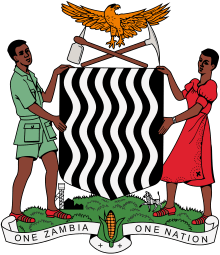Stand and Sing of Zambia, Proud and Free
 | |
|
National anthem of | |
| Also known as |
Lumbanyeni Zambia English: Stand and Sing of Zambia, Proud and Free |
|---|---|
| Music | Enoch Sontonga, 1897 |
| Adopted | 1964 |
"Stand and Sing of Zambia, Proud and Free" is the national anthem of Zambia. The tune is taken from the hymn Nkosi Sikelel' iAfrika (God Bless Africa), which was composed by a South African, Enoch Sontonga, in 1897. The lyrics were composed after Zambian independence to specifically reflect Zambia, as opposed to Sontonga's lyrics which refer to Africa as a whole.
History
Nkosi Sikelel' iAfrika started to become popular in South Africa in 1923 as a Christian hymn. Its popularity spread around Africa through churches and the tune became associated with African nationalism movements. Following the passing of the Zambia Independence Act 1964 in the Parliament of the United Kingdom enacting Zambia's independence from the United Kingdom, Nkosi Sikelel' iAfrika was adopted as the national anthem of Zambia,[1] replacing God Save the Queen, the anthem of Northern Rhodesia. Shortly afterwards, it was decided that new words set to the tune of Nkosi Sikelel' iAfrika would be needed for Zambia's national anthem. A national competition was held for the new words. However, none of the entries were deemed good enough to be used in full for the anthem. As a result, six of the entries were merged to create "Stand and Sing of Zambia, Proud and Free" and the entrants selected were awarded prizes. The authors credited for the composition were G Ellis, E.S. Musonda, J.M.S. Lichilana, I Lowe, J Sajiwandani and R.J. Seal.[1]
In 1973, the National Assembly passed the National Anthem Act, which legally defined the English lyrics of "Stand and Sing of Zambia, Proud and Free" as the national anthem of Zambia. The Act also made it an offence to "insult or bring into contempt or ridicule" the anthem and granted the President of Zambia the rights to prescribe how the anthem is sung and to restrict its use.[2]
In 2005, Zambian women's groups petitioned for a number of the lyrics in "Stand and Sing of Zambia, Proud and Free" to be changed because they felt that they were too male orientated. In response, it was decreed that the current lyrics did include women in context and it was stated that "Stand and Sing of Zambia, Proud and Free" was "composed of historical lyrics that reflect the country's heritage."[3] In 2012, Professor Michelo Hansungule repeated the concerns that the anthem was too masculine. He also argued that because it had the same tune as the National Anthem of South Africa, it might have intellectual property implications and suggested that Zambia's sovereignty could be questioned.[4]
Lyrics
|
|
||||
|---|---|---|---|---|
|
|
|
|
|
|
|
|
|
|
|
|
|
|
|
(Sung After Third Verse Only) |
|
|
|
|
References
- 1 2 "Zambia's national anthem: a history". Zambezi Traveller. 2013-06-26. Retrieved 2014-04-30.
- ↑ "National Anthem Act, Cap 7". Zambia Legal Information Institute. 1973-09-14. Retrieved 2014-04-30.
- ↑ "Zambia Âť". Nationalanthems.info. 1964-10-24. Retrieved 2014-04-30.
- ↑ Chanda, Ernest (2012-08-29). "Coat of Arms, National Anthem outdated - Prof Hansungule". The Post. Retrieved 2014-04-30.